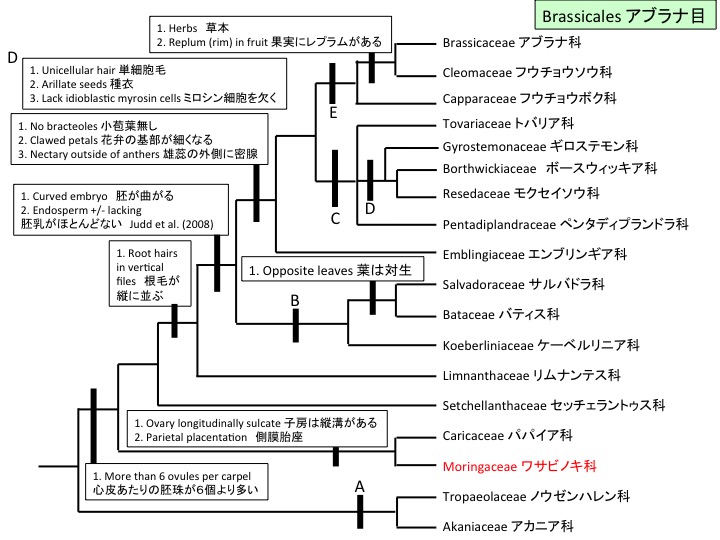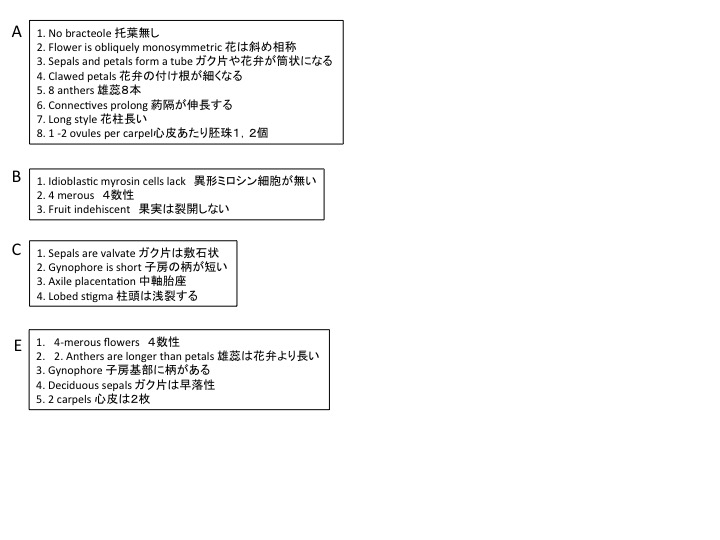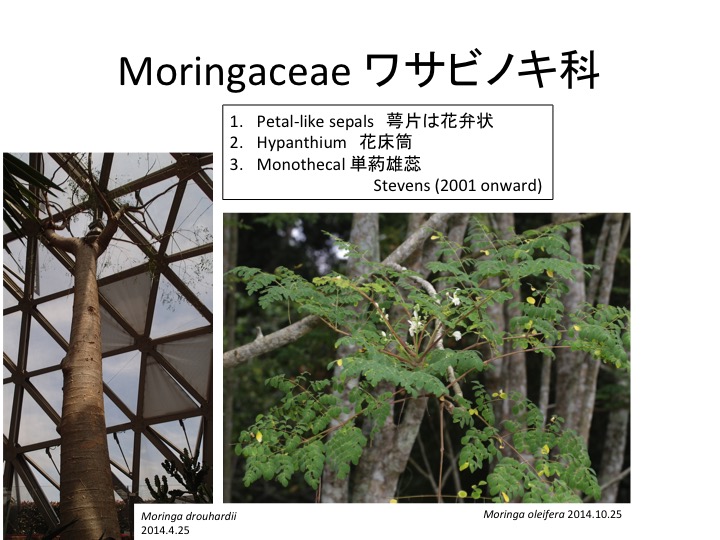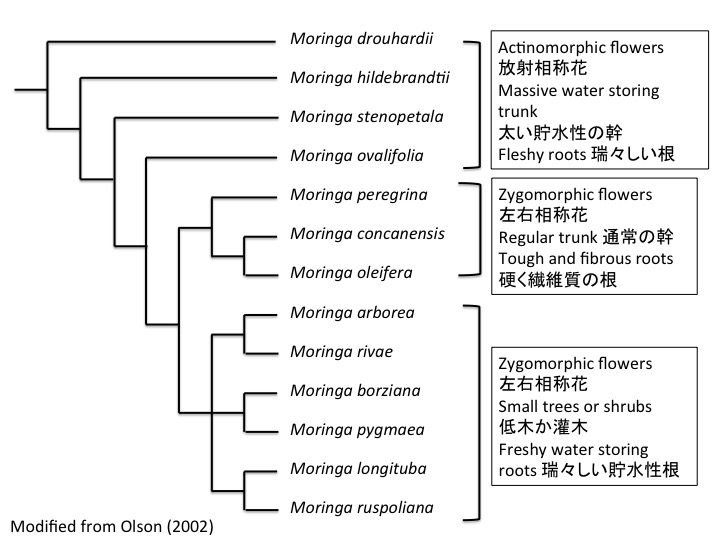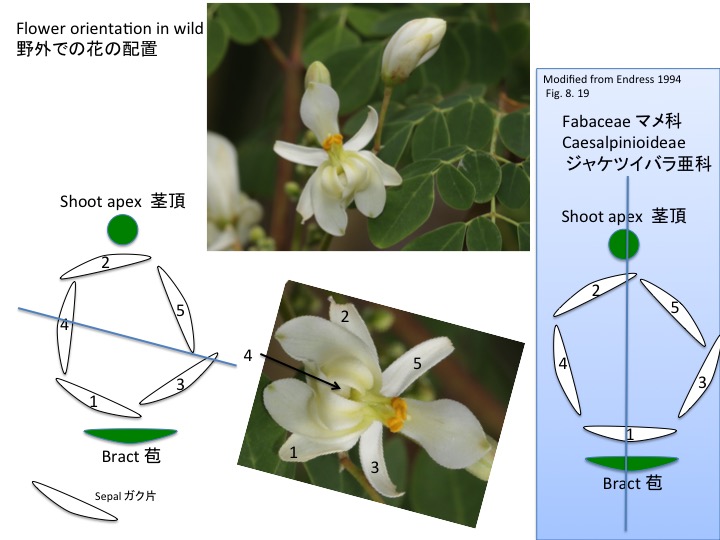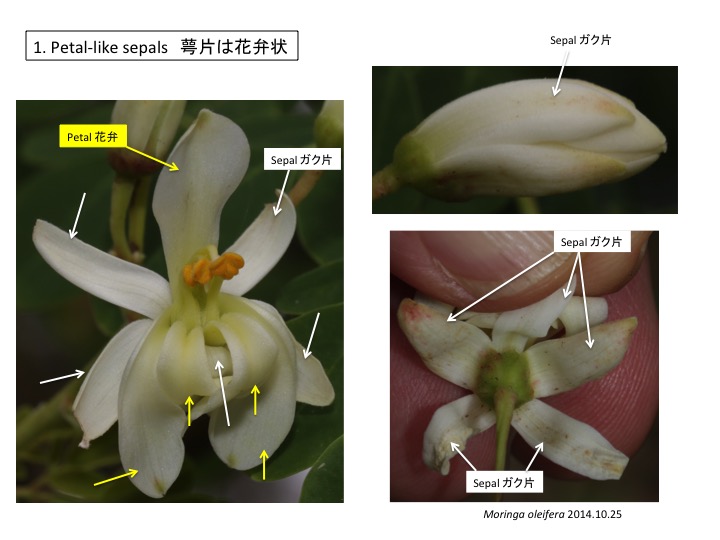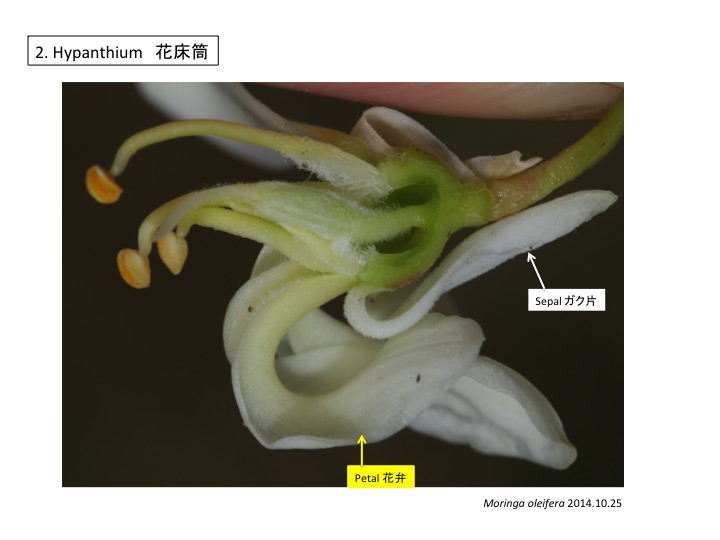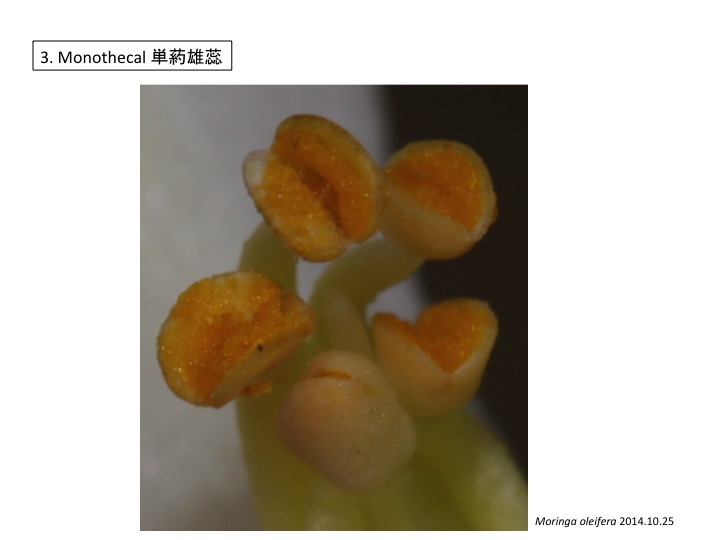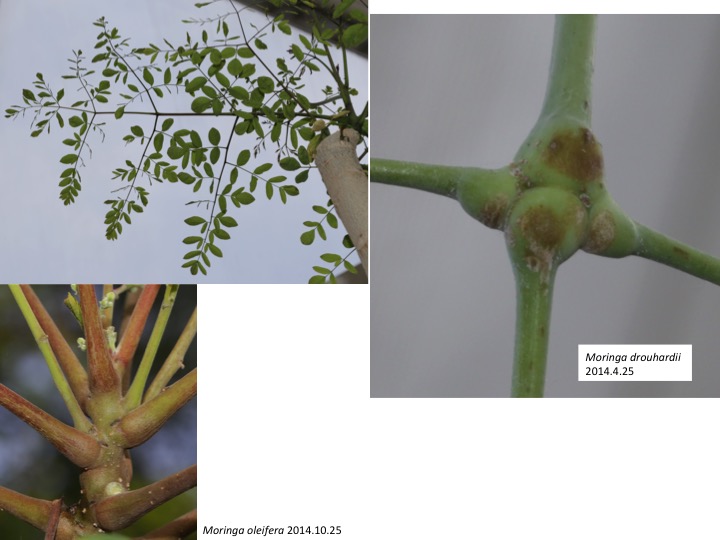ワサビノキ科はワサビノキ属のみを含む木本で、インドからアフリカ東部、アフリカ西部の一部、マダガスカルに分布する。Moringa oleiferaは葉や実が野菜として用いられる。種子はプラスの電荷を持ったタンパク質を含み、粉にして、泥水などの浄化、手洗いに使われる(Ghebremichael et al. 2005)。
The Moringaceae is woody and distributed from India to East Africa, a part of West Africa, and Madagascar. Moringa oleifera is used as vegetables for their leaves and seed pods. Seeds contain positive charged proteins and are crushed to be used for water purification to precipitate negative charged soils and dirty matters (Ghebremichael et al. 2005).
Ghebremichael, K. A., Gunaratna, K. R., Henriksson, H., Brumer, H., and Dalhammar, G. (2005) A simple purification and activity assay of the coagulant protein from Moringa oleifera seed. Water Res 39: 2338–2344.
系統解析の結果、放射相称花を持ち、貯水性の太い幹となる4種が基部に側系統として分岐し、Moringa oleiferaを含む細い幹を持つ3種の単系統群と地下に貯水根を形成する低木となる6種の単系統群が姉妹群となる (Olson 2002)。2つの単系統群はともに左右相称花を持つ。
Species with bottle-like water storage stout stem including Moringa drouhardii form a basal paraphyletic grade. Species with slender woods and those with water storage stout root form sister clades.
Olson, M.E. 2002. Combining data from DNA sequences and morphology for a phylogeny of Moringaceae (Brassicales). Syst. Bot. 27: 55-73.
Olson and Rosell (2006) は維管束の木部、師部の構成を比較し、太い貯水性の幹を持つ種の発生初期に段階に幹が太くならない種の維管束の発生様式が似ていることと、太い幹を持つ種が基部に位置することから、太い幹が祖先形質で、その他の種の幹は太い幹の発生過程が遅れた幼型成熟(neoteny)によって進化したと提案している。発生過程は遺伝子ネットワークの組み合わせで出来ているのでそのようなことがおこっても不思議ではない。しかし、一体となって機能している発生過程の一部を止めてしまっても問題無いのだろうか。幼型成熟で実際にどのようにネットワークが組み替わるのかはわかっていない。
Olson and Rosell (2006) compared xylem and phloem among Moringa species. They found that the development of stems in slender trees or tuberous shrubs is similar to that of early developmental stages of bottle tree stems. With incorporating the basal clustering of bottle trees in the Moringa phylogenetic tree (Olson 2002), they speculated that non bottle trees evolved by neoteny of bottle trees: delayed developmental process. It is still unknown how developmental networks are reorganized.
Olson, M.E., and Rosell, J.A. (2006). Using heterochrony to detect modularity in the evolution of stem diversity in the plant family moringaceae. Evolution 60: 724-734.
ワサビノキ属は13種を含み、花が放射対称の種が4種、左右相称の種が9種ある。花発生の比較解析から、放射相称、左右相称のどちらの花を形成する場合も、初期の花原基は左右相称であることがわかった(Olson 2003)。
The genus Moringa includes 13 species, in which four and nine species form actinomorphic and zygomorphic flowers, respectively. Olson (2003) showed that early floral buds are zygomorphic in any species regardless of their matured flower types.
Olson, M.E. (2003). Ontogenetic origins of floral bilateral symmetry in Moringaceae (Brassicales). Am J Bot 90, 49-71.
転写因子をコードするCYCLOIDEA(CYC)遺伝子はキンギョソウの向軸側発現し、CYC機能が欠損すると左右相称の花が放射相称になる。従って、CYCは左右相称性を制御している (Luo et al. 1996)。シロイヌナズナの花は放射相称であるが、stage 1と2の花原基ではCYCのオルソログであるTCP1 mRNAが向軸側に発現し、stage 3以降は発現が消失する (Cubas et al. 2001)。このことは、シロイヌナズナの初期発生段階は左右相称のプログラムが機能し、のちに、放射相称のプログラムが解発されると考えられる。最初に放射相称の発生プログラムが機能し、後で放射相称になる点がワサビノキ科に似ている。
CYCLOIDEA (CYC) encoding a transcription factor in Antirrhinum majus is expressed in the adaxial side of a floral primordium. The loss of function of CYC changes wild-type zygomorphic flowers to actinomorphic ones and CYC regulates asymmetry in flower development (Luo et al. 1996). Even though Flowers of Arabidopsis thaliana is actinomorphic, TCP1, CYC ortholog mRNA is asymmetrically expressed only in adaxial side during stages 1 and 2, and after stage 3, the expression diminishes (Cubas et al. 2001). These suggest that actinomorphic developmental program functions after zygomorphic one does. This is similar to the case in Moringa.
Cubas, P., Coen, E., and Zapater, J.M. (2001). Ancient asymmetries in the evolution of flowers. Curr Biol 11, 1050-1052.
Luo, D., Carpenter, R., Vincent, C., Copsey, L., and Coen, E. (1996). Origin of floral asymmetry in Antirrhinum. Nature 383, 794-799.
ワサビノキ科の姉妹群であるパパイヤ科の花は放射相称で、花原基の調べられた全ての段階で放射相称である(Ronse Decraene and Smets1999)。しかし、シロイヌナズナのようにCYC遺伝子の発現様式が放射相称になっていない可能性もある。放射相称の花を作るのにどうして最初に左右相称の発生様式を維持しているのだろうか。
Carica papaya in the Caricaceae, sister to the Moringaceae forms actinomorphic flowers and the primordia do not pass the zygomorphic stage as in the Moringaceae, although expression patterns of CYC homologs have not been examined. Why zygomorphic development is proceeds to actinomorphic one in the Moringa species and Arabidopsis thaliana?
Ronse Decraene, L. P., and Smets, E. F. 1999. The floral development and anatomy of Carica papaya (Caricaceae). Can. J. Bot. 77: 582-598.
左右相称花の場合、中心軸は茎頂と苞をつないだ方向になることがほとんどであるが、ワサビノキ属の左右相称花の場合、軸が斜めになっている。CYC遺伝子など左右相称性形成に関わる遺伝子の発現や機能がどのように変化しているかを調べることで、左右相称軸がどのように決定されるかが理解できるようになるかもしれない。構造的な問題に加え、どうして軸が斜めになったのか、適応的な意義はあるのだろうか。
An axis of a zygomorphic flower is usually formed on the line connecting a shoot apex and a bract. The zygomorphic flowers of Moringa have an axix oblique to the line connecting a shoot apex and a bract. Analyses of genes involved in zygomorphic flower development such as CYC will give insight on the molecular mechanisms to form the axis.
複葉の小葉の付け根は関節する。どうして関節するのか?
Bases of pinnae and leaves are articulated, although the reason is unknown.

